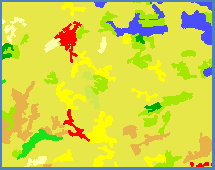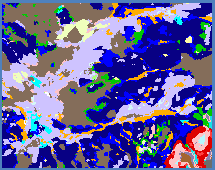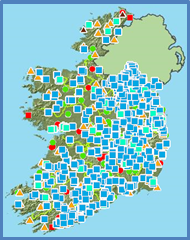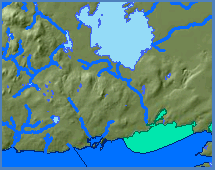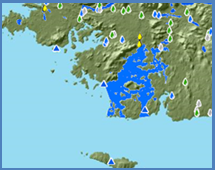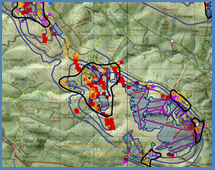As part of work done for the implementation of the Water Framework Directive, Ireland’s waters have been mapped in GIS format. This data is freely available to
download: in full for OSI vector data license holders and as a generalised less detailed set for those who don’t hold the OSI license.
INSPIRE metadata files have been created for all this data which can be used with this user information to help get the most from this valuable data resource.
Rivers
What does this data show me?
Mapping of Ireland’s rivers in GIS format was started in 2002 using the Ordnance Survey of Ireland Discovery Series water lines as the starting point. These lines
were joined together to create complete river stretches and each stretch was given a name either from the Discovery Series map or from the EPA river monitoring program.
Three key datasets make up the Rivers data package:
- A geometric river network, which can be used with network analysis tools such as ESRI’s utility network analyst, to trace upstream and downstream. The river network is
stored as an ArcGIS 10.1 file geodatabase where it is presented via hydrometric area. In early 2016 this data was made available under Creative Commons Attribution license 4.0 by agreement with the OSI.
- A river routes shapefile of Ireland’s rivers at a scale of 1:50,000 showing rivers as complete lines attributed with name and Strahler river order. This lines shapefile is built from the river network areas. In early 2016 this data was made available under Creative Commons Attribution license 4.0 by agreement with the OSI.
- Water Framework Directive (WFD) river water bodies, which are the management and reporting units for the WFD. River stretches are grouped together based on common
quality status and physical characteristics to form units. This data is formed from the river routes shapefile. The first river water bodies file created in 2004 is
being revised and updated and will be released in 2014.
If this data is not what you are looking for, or you require larger scale data, you should contact the Ordnance Survey of Ireland.
What is the data quality and/or fitness for purpose?
This data is mapped at a scale of 1:50,000 and is considered fit for purpose at this scale. Network analysis of the river network will provide accurate results at this
scale but will not represent smaller streams and drains visible at larger scales and so should not be used for very detailed studies of smaller catchment areas.
Data Completeness: The data is considered to be >95% complete at a scale of 1:50,000: if a river is visible at this scale it is appears in the EPA rivers files.
At larger scales the data is less complete: while some small streams and drains are included this is done where they occur on the EPA river monitoring programme
or have been identified as significant for other reasons (e.g. licensed emissions, changing the flow direction of rivers etc.). No formal survey of small streams
and drains has been undertaken so the data should be considered fit for purpose at 1:50,000.
Data Precision: The data was gathered from the OSI Discovery series vector data product (1:50,000 scale). This data was gathered pre-2000, some small lakes
have been added using either OSI orthoimagery (2005) or OSI large scale maps as a source. Lakes have been checked against rivers data to ensure that all
lakes are properly connected to the river network where they occur along it.
Data Accuracy: Lake areas are calculated in ArcGIS. Lake segment codes are unique. 37% of the records have been attributed with a name, approximately 35%
or more is taken directly from the OSI Discovery series but the remaining names were taken from local features such as townlands or larger rivers downstream
and so represent a logically assigned name rather than the name that may be used locally.
Data Consistency: All lakes are represented as polygons, all lakes in the lake water bodies shape file are validated by EPA Scientists as being freshwater
lakes rather than estuarine water (this has not been done for the complete lake segment file).
How up to date is it?
The data was generated from the OSI Discovery Series source, dated 2000. A low number of small lakes have been added since then from more recent sources
(OSI 2005 images and/or field observations by EPA scientists).
Where can I get this data?
You can view the data using our WebGIS on the Map link, under the Water Features group and WFD Status 2007 – 2009 group.
Request this data via the Contact Us page:
- If you have an OSI license, please supply us with the license number and we’ll send you the full national shapefile.
- If you don’t have an OSI license use Contact Us to request the generalised version.
Lakes
Mapping of Ireland’s lakes in GIS format was started in 2002 using the Ordnance Survey of Ireland Discovery Series water polygons as the starting point.
Polygons were closed and each polygon was given a name either from the Discovery Series map or from the EPA river monitoring program: 37% of the records have a name.
What does this data show me?
Two datasets make up the lakes data package:
- Lake segments: a file of polygons showing lakes that appear on the 1:50,000 Discovery Series map, with some smaller lakes included where they have been identified
as significant (e.g. drinking water abstraction, protected site etc.). This shapefile has <12,000 records. In early 2016 this data was made available under Creative Commons Attribution license 4.0 by agreement with the OSI.
- Water Framework Directive (WFD) lake water bodies, which are the management and reporting units for the WFD. About 800 lakes are identified as WFD lakes
either due to their size or their significance as a habitat, drinking water source, use as recreational water or other reason. This data is available to all users.
If this data is not what you are looking for, or you require larger scale data, you should contact the Ordnance Survey of Ireland.
What is the data quality and/or fitness for purpose?
This data is mapped at a scale of 1:50,000 and is considered fit for purpose at this scale: it should not be used for very detailed studies of smaller catchment areas.
Data Completeness: The data is considered to be >98% complete at a scale of 1:50,000: if a lake is visible at this scale it is appears in the EPA lake segments file.
At larger scales the data is less complete: while some small lakes are included this is done where they occur on the EPA lake monitoring programme or have been identified
as significant for other reasons. Some but not all turloughs appear so the data is not complete for these types of lake. No formal survey of small lakes has been undertaken
so the data should be considered fit for purpose at 1:50,000.
Data Precision: The data was gathered from the OSI Discovery series vector data product (1:50,000 scale). This data was gathered pre-2000, some small lakes have been
added using either OSI orthoimagery (2005) or OSI large scale maps as a source. Lakes have been checked against rivers data to ensure that all lakes are properly
connected to the river network where they occur along it.
Data Accuracy: Lake areas are calculated in ArcGIS. Lake segment codes are unique. 37% of the records have been attributed
with a name, approximately 35% or more is taken directly from the OSI Discovery series but the remaining names were taken
from local features such as townlands or larger rivers downstream and so represent a logically assigned name rather than the
name that may be used locally.
Data Consistency: All lakes are represented as polygons, all lakes in the lake water bodies shape file are validated by EPA
Scientists as being freshwater lakes rather than estuarine water (this has not been done for the complete lake segment file).
How up to date is it?
The data was generated from the OSI Discovery Series source, dated 2000. A low number of small lakes have been added since
then from more recent sources (OSI 2005 images and/or field observations by EPA scientists).
Where can I get this data?
You can view the data using our WebGIS on the Map link,
under the Water Features group and WFD Status 2007 – 2009 group.
Request this data via the Contact Us page:
- If you have an OSI license, please supply us with the license number and we’ll send you the full national shapefile.
- If you don’t have an OSI license use Contact Us to request the generalised version.
Groundwater
Mapping of Ireland’s groundwater in GIS format was completed in 2004 after collaboration between the Geological Survey of
Ireland and the groundwater team of the EPA. The starting point was an aquifer map of Ireland which showed the hydraulic
boundaries of flow.
What does this data show me?
Groundwater bodies are determined from this starting point: an aquifer must be classed as a waterbody if it is capable of
serving 10m3/day of abstraction or if significant abstraction from the aquifer would damage a related terrestrial or
surface water ecosystem (either by the impact of removing the water directly or by the changes in the chemical status of
the water brought about by the abstraction).
What is the data quality and/or fitness for purpose?
This data is a representation of water bodies designated for the Water Framework Directive and it is intended to be used
within this remit.
Data Completeness: The data is considered to be >95% complete: if a groundwater body is capable of serving 10m3/day of
abstraction, or has other significance, it is designated as a groundwater body.
Data Accuracy and Precision: Aquifer mapping and classification was based on Geological Survey of Ireland source data.
See http://www.gsi.ie/Programmes/Groundwater/Aquifer+Classification.htm
to access details of how aquifers were classified.
Data Consistency: All groundwater bodies are represented as polygons, all groundwater bodies in the shapefile are
validated by scientists in the Geological Survey or Ireland and the EPA Scientists as meeting the criteria for a
Water Framework Directive groundwater body.
How up to date is it?
The data was generated from GSI geology source material in 2004. An update is currently underway and should be available
during 2014.
Where can I get this data?
You can view the data using our WebGIS on the Map link,
under the Water Features group and WFD Status 2007 – 2009 group.
You can download the data from the EPA Database option of the Get data page.
The national shapefiles are available under the Water option.
Transitional and Coastal
Transitional waters are bodies of water near the coast that are partially saline but still strongly influenced by
freshwater flow. Coastal water bodies commence at the high water mark or at the boundaries of transitional water bodies
and extend 1 nautical mile out to sea.
What does this data show me?
Transitional and coastal water body polygons fit with the lakes and rivers GIS layers to give a complete national
picture of water from river sources through lakes and right out off the coast. The transitional and coastal water
polygon shapefiles show the areas of water that EPA Scientists have assessed to have hydrological and ecological
characteristics that make them discrete areas of water.
What is the data quality and/or fitness for purpose?
This data is a representation of water bodies designated for the Water Framework Directive and it is intended
to be used within this remit.
Data Completeness: Coastal water bodies extend out to the 1 nautical mile limit from either the high water mark
or the transitional water boundary and so represent complete coverage of the assigned coastal water area.
Transitional water body boundaries extend from either tidal limits of rivers or high water marks but in some cases
the exact boundary between the river and the transitional water has been assigned based on expert opinion and may
be revised as a result of field studies.
Data Precision: The high water mark was generated from OSI six inch mapping. Outward boundaries of 1 nautical
mile are generated from this line. Internal water body boundaries were delineated based on the assessment of
EPA Scientists following WFD guidance material prepared at European level on the delineation of water bodies.
Data Accuracy: Names and codes are unique and all water bodies have been assigned these attributes. Type and
salinity attributes were assigned by EPA Scientists on the basis of field surveys and scientific models.
Data Consistency: All water bodies are represented as polygons, transitional and coastal water bodies share
boundaries and do not intersect. All names and codes are unique across both datasets so that they can be used
as a single data resource.
How up to date is it?
The data was generated from OSI source material in 2004. The boundaries were last reviewed and updated in 2012.
Where can I get this data?
You can view the data using our WebGIS on the Map link,
under the Water Features group and WFD Status 2007 – 2009 group.
You can download the data from the EPA Database option of the Get data page.
The national shapefiles are available under the Water option.
This data doesn’t have a regular update schedule, but may be amended from time to time. Check the “notify me for updates” option when you download this data to receive an email when the new data is available.
